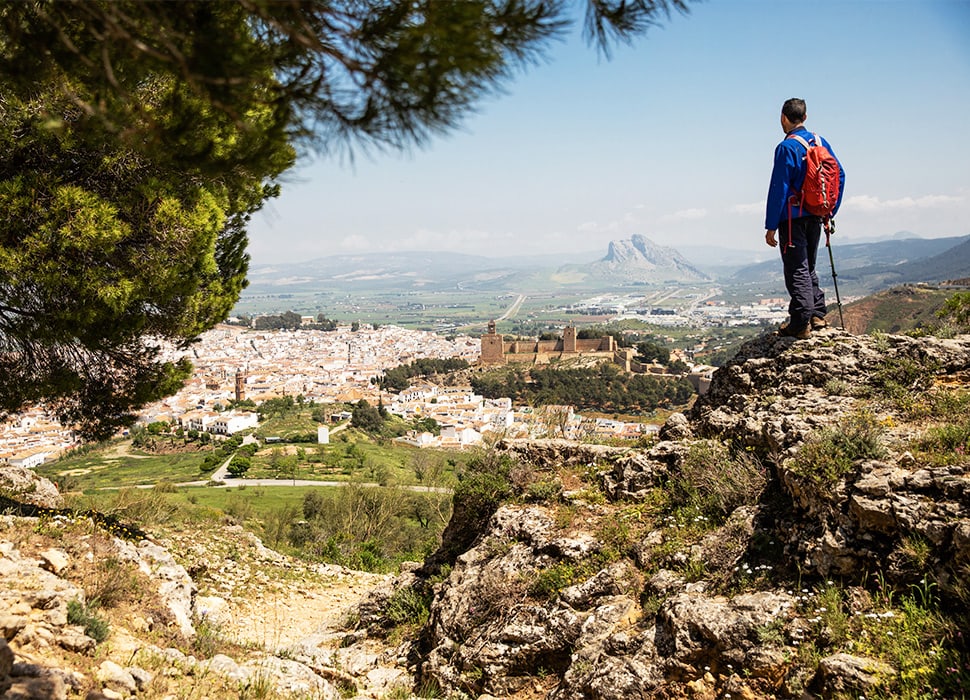Porra de Naranja (gazpacho with oranges) at Art de Cozina / Image: Tim E White
At Art de Cozina restaurant, in the fortress town of Antequera, we stop for a lunch of porra (gazpacho with oranges), zarangollo (paprika-scrambled eggs with courgette) and almojábanas (sweet cheese bread) under the watchful eye of chef Charo Carmona and her sons Francisco and Luis Martinez Carmona. In homage to the area’s Muslim history, the family is bringing back long-forgotten dishes once made along the route. Imagine medieval pilgrims on tour, feasting on partridge, acorn-stuffed trotters and stewed cow’s tongue, then transport this idea to a modern-day, sunlit bodega. “The Arab influence here is undeniable,” says Francisco, pouring a glass of rosé. “Almojábanas made the journey from souks in the Middle Ages to Spanish convents. Now it’s for hikers.”
On Roman trade routes and mule tracks, passing stone way markers and monasteries, the Camino troops north. We climb out of the Guadalhorce river valley and pass el Cedrón, a village settled by Sephardic Jewish communities after the reconquest of Granada in 1492. The map shows Castro de Río, a crossroads best known for being where Miguel de Cervantes started writing Don Quixote from behind the bars of the jail.
By the time we reach Zuheros, a hilltop hamlet topped out by an Arabic watchtower, the sun is setting on our penultimate day. From the Sierras Subbéticas Natural Park to the east the land flattens. The afternoon heat has scoured the village of life and those we do meet are bemused by our journey. “Hombre!” cries one sun-wrinkled farmer, shaking his crook to the sky. “Only my goats are crazier than you!”
La Mezquita is part mosque, part Catholic cathedral / Image: Tim E White
At the edge of this scene, at the Hotel Hacienda Minerva, we meet Toma & Coe owner Manni Coe, with whom we are to hike our final stretch. “The best way to get to know a country is to walk through it,” he says, gesturing across the valley. The view, of a sea of flowering olive groves and the old railway station which served the region’s now defunct olive train, is one of unparalleled serenity. “I walked the Camino de Santiago every year, but the last 100km always felt like a torrent. Here you have Andalusia’s greatest hits in the palm of your hands.”
After a night of more thick porra and raisin-sweet muscatel, the morning’s trail builds, as does my own compulsion to keep going. Strung-out from the walking and history, yet aware that some part of me has been prised open like a pistachio, I imagine myself spending the rest of the month hiking north to Santiago de Compostela, through the historic cities of Merida, Cáceres and Salamanca, beneath oak and cork trees – the habitat of acorn-snuffling Iberian pigs. Am I in the midst of a personal awakening? Has the Camino found me?
Pleased with this moment of soul-searching, I arrive in Córdoba, crossing its Roman bridge with a final spring in my step. Unlike flamboyant Seville, it strikes me as a contemplative city, and when the sun beats down it is put on pause. Cast-iron balconies and geranium-flowered squares carry a Moorish grace, while the 10th-century Mezquita, a beautiful mosque-church, offers a short history lesson in religious tolerance. In its shadow I meet a handful of other pilgrims – yoga instructor Erin Fleming and friends Laura and Candy from Indianapolis – discussing how they discovered each other and themselves.
Surveying the epic scenery / Image: Tim E White
“Sometimes we let life slip away into the modern world,” says Erin, suddenly welling with emotion. “But the Camino is a chance to reconnect with what’s important. To slow down. To rethink life. It doesn’t stop just because you reach the end. It lives on within you.”
And this is the way it feels to me. The reward is not only from taking the road less travelled. And it goes beyond memorable encounters with bemused goat herders who view the pilgrimage as lunacy. There’s a goose-bump realisation that my outlook has changed, tempered with regret at not having come sooner. No longer, I think, will I lose myself to the city. Life is too short.
The bars and cafés open, the dusky afternoon gathers momentum. Taverna doors swing wide, revealing men drinking beer, while accordionists and flamenco dancers take to the street, garlanded in flowers. As I walk away, I’m left with a sense of harmony, long after the music has died down.
For more information on guided hiking trips along the Camino Mozárabe, visit tomaandcoe.com or call +34 650 73 31 16.
HOLY FAQ!
What’s this pilgrimage all about then?
It’s in honour of Saint James (or Sant Iago as he was known), one of Jesus’s 12 Apostles who King Agrippas had beheaded in AD44.
Ouch. So, what’s Sant Iago got to do with Compostela?
According to legend, while St James’s head is buried in a cathedral in Jerusalem, the rest of his remains were taken to Compostela and buried there.
Because…
He preached the gospel on the Iberian Peninsula, hence he’s patron saint of both Portugal and Spain.
Ah. And so people walk to his tomb to honour him?
Yes, exactly. Along at least 15 established routes. The most popular one runs along the northern coast, but the Mozarbic Way is arguably the prettiest.
Any other incentives?
If you were Catholic, you might be walking to be given a plenary indulgence, meaning you’d suffer less when you get to purgatory.
And if I’m not…
For the rest of us, there’s camaraderie, food and drink, time out from modern life and a massive sense of achievement to be gained from having completed the route.
Book flights to Malaga
Book holidays to Malaga




